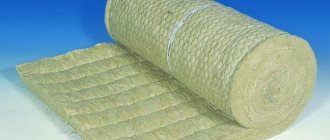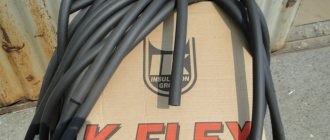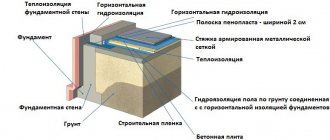What is waterproofing for?
The role of waterproofing in building a house is difficult to overestimate:
- Durability. High-quality building materials do not guarantee the safety of the elements of the house. To do this, it is necessary to protect the walls, foundation and roof from the harmful effects of water.
- Keeping warm in the house. Waterproofing is used in situations where multi-layer installation using thermal insulation materials is applied. If you do not create a barrier to groundwater or rainwater, the thermal insulation layer loses its properties and becomes useless.
How to store roll material
To prevent the deposited coatings from losing their moisture-protective properties, they should be stored under the following conditions:
- set rolls vertically;
- avoid exposure to ultraviolet rays;
- avoid heat sources;
- do not allow moisture to enter.
Rolls must be transported in a transport with a closed body. They can be transported both horizontally and vertically. If the rolls are laid horizontally, no more than 5 layers are allowed, if vertically - no more than 2 layers.
Roofing material - cheap and short-lived
A typical representative of roll materials is roofing material. The low cost of such waterproofing, unfortunately, does not provide durable protection. Usually the shelf life of roofing material does not exceed 10 years.
The main components of roofing material:
- cardboard, which plays the role of the basis for the main waterproofing agent;
- bitumen layer applied to cardboard and providing water resistance of the material;
- a sprinkling of stone chips that protects roofing material from mechanical stress and increases its strength.
The main problem in waterproofing with roofing material is the softening of the cardboard base with prolonged exposure to moisture. A loose structure quickly deteriorates, which is why all the material crumbles over time. Against the background of more expensive types of protection, roofing material is losing its popularity, but is still used for waterproofing technical structures such as sheds, temporary buildings and sheds.
Characteristics of roll-on weld waterproofing for flat roofs
To protect building structures from moisture ingress, several methods are used. The proven and most effective method is deposited insulation. Thanks to the new modern roll-on waterproofing that has appeared on the market, insulation work can now be carried out without difficulty. The material is characterized by increased tensile strength, as it is reinforced with high-quality polyester. Unlike the previously used roofing felt, roofing felts and glassine, the overlaid waterproofing for the roof does not rot or delaminate. The service life of such a coating significantly exceeds its predecessors, due to its waterproofness and resistance to harsh environments.

Is one of the largest suppliers of high-quality insulation materials in Moscow. If you are a developer and you are interested in the wholesale purchase of a certified insulation coating, be sure to look through our catalog. In the meantime, we suggest you familiarize yourself with the popular brands of the Icopal brand:
- Ultradrive.
Differs in its reliability and durability. Builders appreciate this material for its versatility and ease of installation;
- Ultra-nap.
This practical coating is used for the arrangement of reservoirs and reservoirs, as well as for the construction of dams, slopes of an irrigation canal embankment;
- Villaflex.
Fusion waterproofing, the price per m2 of which is favorable for legal entities, is used for arranging flat roofs in any region of our country;
- Villatex.
The strength and durability of the coating, as well as its resistance to temperature extremes, deserves respect. It can be installed in regions with the harshest climates;
- Icopal N and V.
Fusion bonded waterproofing of this brand is often used by large developers. The brand gained its popularity due to its technical characteristics. Construction companies that have purchased this coating for projects under construction have appreciated its durability, strength and ease of installation.
High quality bitumen roll materials
More technological types of roll waterproofing using durable materials as a basis have become a worthy alternative to the outdated roofing material:
- Fiberglass. The water resistance of the coating is provided by bitumen spraying, which is applied to a layer of fiberglass or fiberglass. To give the bituminous layer flexibility and strength, manufacturers add special modifiers.
Benefits:
- durability due to the resistance of fiberglass to decay after prolonged exposure to water, acids and alkalis.
- the ability to select material of different density and purpose;
- soundproofing;
- higher fire safety class;
- thermal stability due to the inclusion of various stabilizers in the bitumen layer, which ensure the softness of the layer during temperature fluctuations.
When choosing a fiberglass-based material, it is better to choose a denser material. In styling, it is more comfortable and smoother.
- Polyester.
Fiberglass is also used for the base of these materials, but with the addition of synthetic resins. This combination provides high elasticity and strength of the material in the event of deformation or tension. Such waterproofing is especially recommended for structures with complex shapes.Benefits:
- high elasticity and preservation of integrity under tension;
- durability, since the material is not subject to destruction in the aquatic environment;
- high resistance to temperature fluctuations, UV rays.
safety and environmental friendliness;
Roll type waterproofing marking
Marking will help to understand the types of roll waterproofing. Manufacturers use a single three-letter scheme. It is easy to decipher the letters on the package: the first indicates the type of base, the second - the front surface, and the third - the purl.
Base marking values: P - roofing material, X - fiberglass, T - fiberglass; E - polyester fiber.
Marking values of protective layers: K - coarse-grained dressing, M - fine-grained, P - protective film, C - self-adhesive surface, B - coating with ventilation channels and C - colored dressing.
The use of polymers in production technology
Roll-type waterproofing materials using polymer modifiers have a high degree of thermal stability. Due to this property, they are recommended to be used for roof protection in hot climates. Some types of rolled waterproofing materials retain their elasticity and integrity when heated above 100 ° C and reduced to -40 ° C. For use in the middle zone, the more affordable euroruberoid, bikrost, uniflex, bipole are most often used. In the production of these materials, a technology is used, due to which bitumen is combined with polymer components and acquires flexibility, resistance to decay and elasticity.
Types of waterproofing in rolls
As the simplest waterproofing, materials such as bitumen, various resins or their mixtures are used. However, this kind of technology for the production of waterproofing materials remained in the last century.
Nowadays, a special bitumen composition is most often used in production, applied to one or another base, with the addition of plasticizing components and various additives, such as crushed rubber or asbestos fibers. The production technology makes it possible to obtain an elastic waterproofing material that is resistant to negative temperatures and moisture.
As the materials most often used in the production of roll waterproofing, the most widespread are fiberglass and polyester.
The base made of fiberglass or fiberglass is distinguished by its durability and resistance to destruction in a humid environment. The only drawback is that the roll-up waterproofing on a fiberglass base can break if laid inaccurately.
If polyester is used as the base, then this type of material has the best elasticity, which makes it possible to carry out work even in the cold season, since the bitumen mixture does not peel off from the base.
Features of laying bitumen roll waterproofing
Laying the coating is carried out taking into account the peculiarities of the type of roll waterproofing. But there are general requirements that must be followed without fail.
- Surface preparation consists of thorough cleaning of dirt, debris and dust. This helps to create good adhesion of the protective layer to the structure. If there are any irregularities, cracks and protrusions, they are pre-sealed with a special plaster and treated with a primer.
- Measure the length of the pasting area and cut the required length from the roll.
- At the stage of laying the roll waterproofing, depending on the manufacturer's recommendations, use bituminous mastic for gluing the canvas or use other adhesives. Fused bitumen materials may require some skill from the craftsman. The rolled-up web is laid at the beginning of the surface to be treated, the adhesive side is heated with a gas burner and the web is leveled. To create high-quality protection and good adhesion over the entire plane, you should evenly heat the adhesive side of the material and press the web against the surface. Close attention should be paid to the joints of the canvases, a poor-quality connection can cause problems with wetting the walls or roof.
Brief description of the production of rolled waterproofing TechnoNIKOL
The production process of TechnoNIKOL waterproofing is quite simple and is now significantly automated. The conveyor is charged with a base coil (polyester, fiberglass, fiberglass, cardboard), the web is pulled by rollers into a bath in which a bitumen or bitumen-polymer binding mixture circulates, and the web is washed. The bitumen-coated web is cooled and rolled into rolls. On the production conveyor, it is possible to sprinkle a protective layer on both sides of the canvas, install a special self-adhesive layer, and produce multi-composite roofing sheets.
To understand what makes up the cost of rolled waterproofing of a flat roof TechnoNIKOL, the following components can be distinguished:
- Variety of the base (its presence)
- Organic layer composition
- The presence of plasticizers and modifiers of the organic layer
- Using sprinkles
- Production of multilayer canvas
By the name of the roof, you can determine which base is used, whether there is a dressing or a film, for example, Uniflex TKP, where the name of the TKP series is deciphered as a material knitting on fiberglass, which has a coarse-grained dressing of the upper layer and an indicator film of the lower layer.


The presence of a free-flowing layer increases the cost of the series by 10-15%, while maintaining other components Source maxni.ru
Advantages of roll waterproofing
Despite its requirements for surface preparation and the need for cutting out and measuring, roll waterproofing has many advantages.
Rolled waterproofing based on fiberglass and fiberglass
In our store you can find a wide selection of roll waterproofing TechnoNIKOL economy class, made on the basis of fiberglass and fiberglass.
Technoelast HPP-3.0 mm (10 m2). The material is made on the basis of fiberglass, it is used as a bottom layer when arranging roofs with a slight slope. With its help, waterproofing of foundations and floors between floors is also performed. Technoelast HPP is widely used for waterproofing in swimming pools, bathrooms and boiler rooms. Fiberglass, impregnated with polymer bitumen binder on both sides, does not rot under the influence of moisture.
The coating is melted onto the surface using a propane torch.
Gidrostekloizol Technonikol. Roll waterproofing for foundations, plinths, interiors and roofs. Several varieties are produced. Gidrostekloizol KhPP and KhKP are made on the basis of fiberglass. And the difference between the models is that HKP has crumb sprinkling on one side, while HSP has a film on both sides.
In the production of Gidrostekloizol TPP and TKP, fiberglass is used as a reinforcing base. On the model with the letter K in the marking, one side is also sprinkled with large crumbs.
Uniflex TechnoNIKOL. Models TKP and TPP are obtained by applying a bitumen-polymer binder to glass fabric. For the production of Uniflex HPP, fiberglass is used as a base.
Uniflex TKP with coarse-grained dressing on the front side is intended for arranging the top layer of waterproofing. A coating with a polymer film on both sides is used as the bottom layer of multilayer waterproofing of buildings and structures.


How to choose the type of roll material for waterproofing
The choice of material should be based on the following criteria:
- the degree of durability, which is determined by the shelf life on the package;
- the ability to maintain its properties under prolonged exposure to UV rays, which is important in the case of direct contact with solar radiation;
- strength and ability to withstand the pressure of water in the case of pasting the foundation and walls of basements;
- cost is a rather conditional criterion, since a high price does not always guarantee quality;
- ease of installation (materials on an adhesive basis are convenient, which do not require the use of bituminous mastics).
The choice of a specific type of bituminous roll waterproofing depends on the room in which it will be performed. High-quality waterproofing assumes durable and effective protection of the premises from water ingress from the street.
Classes of roll waterproofing materials
This classification brings together materials in accordance with their performance properties, service life, value for money. One class may include materials with different bases, types of protective coatings, methods of fastening.
Premium class
It includes the most advanced coatings with the best biostability indicators, a wide range of operating temperatures and a service life of 25-30 years. A wide selection of bases - fiberglass, fiberglass, polyester fabric. An example of materials of this class is the Filisol series.Filisol roll waterproofing materials have a wide range of applications in construction and repair work. The only limitation is the price - the highest in the line.
Business Class
Yielding in durability and performance only to premium materials, they provide reliable protection of surfaces from moisture for 15-20 years. Depending on the field of application, they are produced with a backing made of fiberglass, fiberglass, polyester fabric. The composition and thickness of the bitumen-polymer component is inferior to materials of a higher class, but the price per square meter is also lower. The representatives of the class in the line of materials are the materials of the "Filikrov" series.
The use of business-class waterproofing in roofing in individual housing construction, construction and repair of buildings and structures, as well as for gluing waterproofing of foundations and floors, ensures the reliability of the object's operation for a long time.
Standard class
This class of roll waterproofing is considered to be the optimal combination of price, quality and durability of materials. Like representatives of higher classes, they can be used for roofing, when laying foundations and blind areas, in waterproofing floors and walls. Representatives of the class in the line of materials (service life 10-15 years) and "Gidrostekloizol" (service life from 8 years). The basis is fiberglass or fiberglass. The bituminous component provides excellent performance throughout its entire service life.
Economy class
The most affordable waterproofing materials, significantly inferior to representatives of other classes both in performance and durability. Roll waterproofing of economy class is designed for a service life of up to 5 years. They are mainly used as a temporary coating or for waterproofing in the construction of non-critical structures and structures. The economy class includes roofing felt, glassine used so far, as well as modern building materials based on fiberglass - "Gidroizol" and others.
The choice of the type and class of waterproofing depends on a number of factors, and not the least of them is the price. But it should be borne in mind that in the long term, materials of a higher class demonstrate an advantage in efficiency, durability and in the final cost. For example, during the service life of a Filisol roof, a roof made of a standard material will have to be replaced 3 times, and an economy one - 5 or more.
The correct choice of roll waterproofing will save the structure from the destructive effects of moisture, and you will save yourself from unnecessary expenditures of funds, effort and time.






















